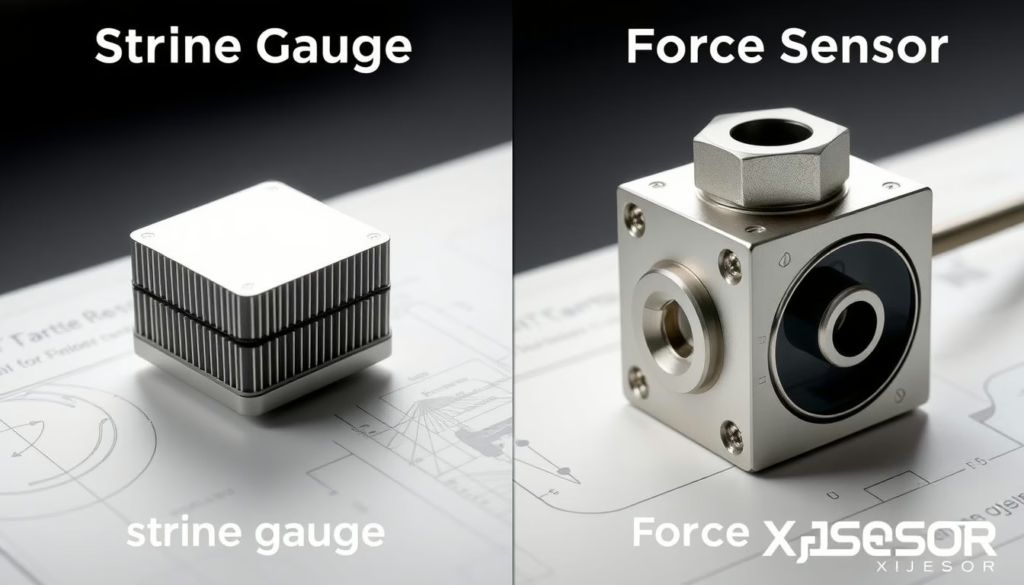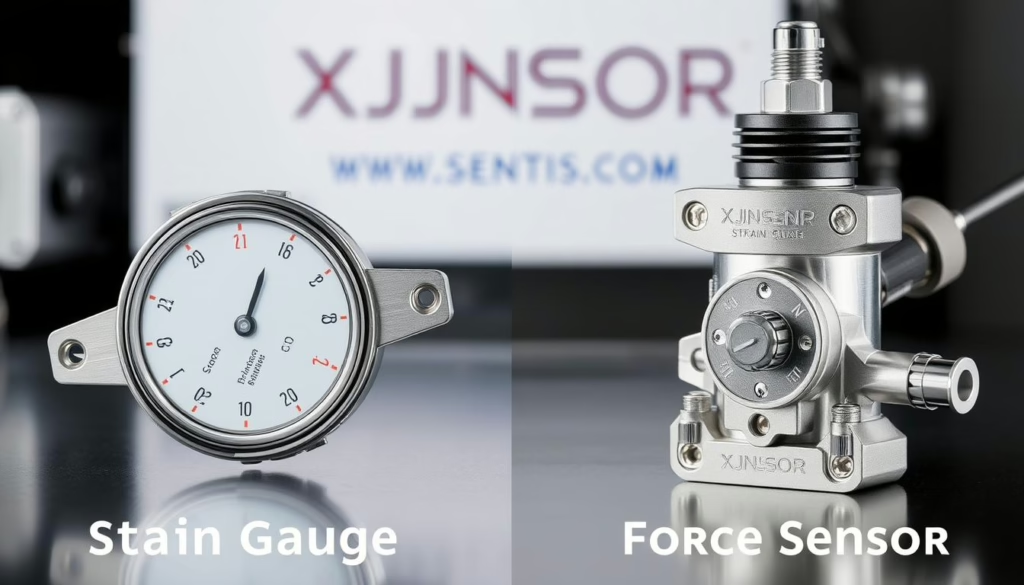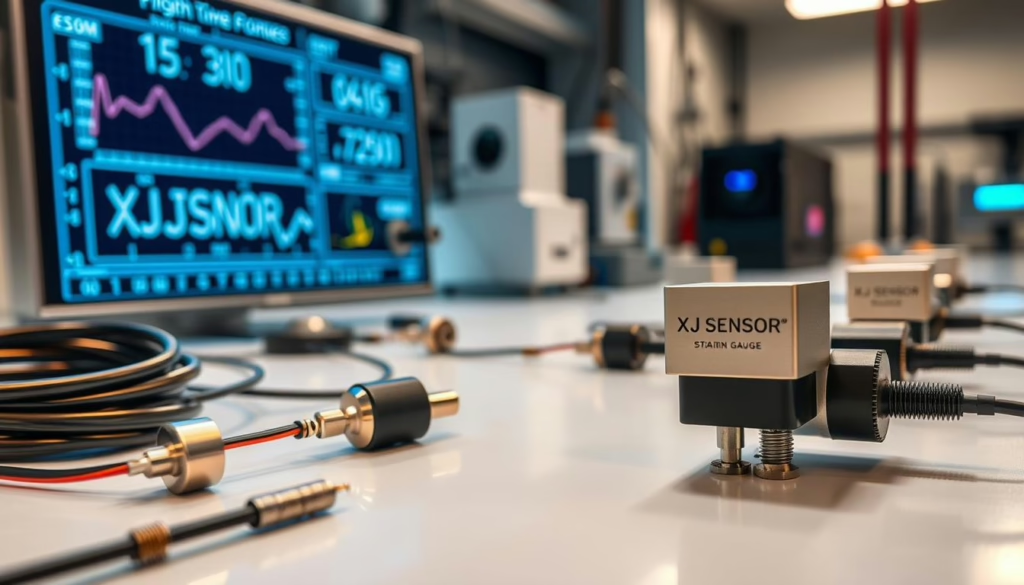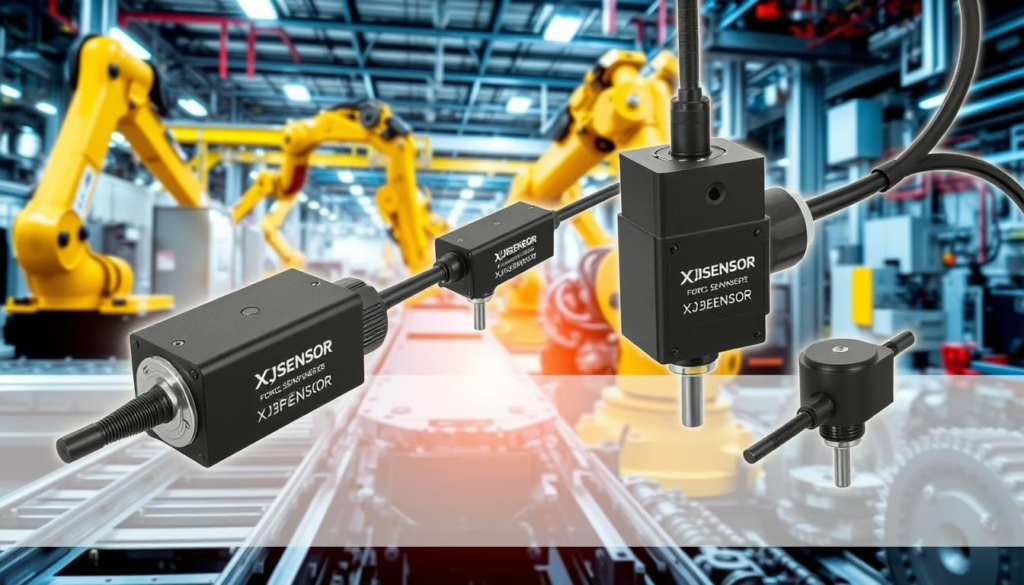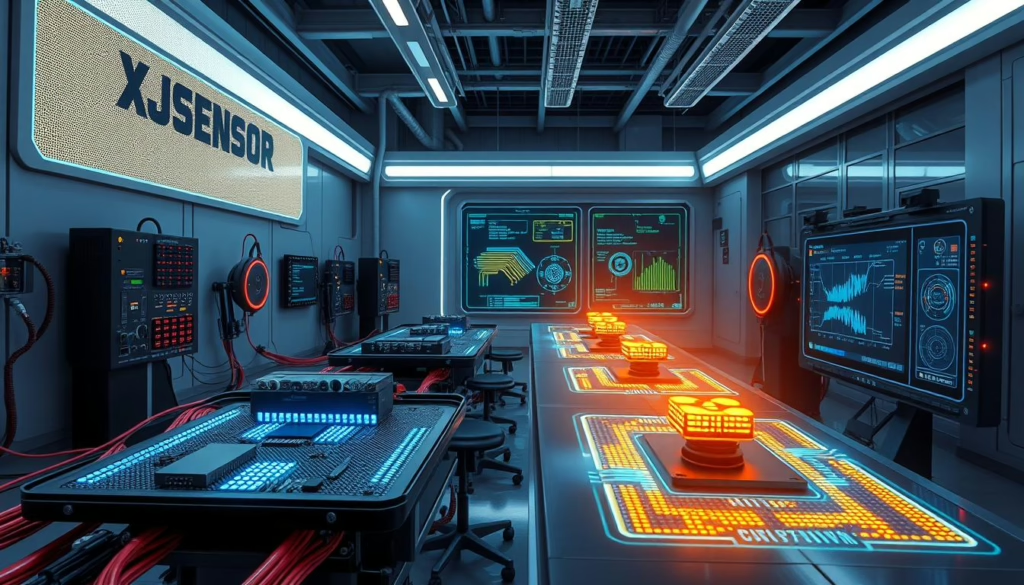Are you trying to choose the right tech for your project? Knowing the differences between strain gauges and force sensors is key. They’re crucial in fields like manufacturing, automotive, and aerospace. Each sensor type measures different things in unique ways. Let’s dive into how they differ and where each shines.
Key Takeaways
- Strain gauges and force sensors have distinct functionalities and are used in different applications.
- Selecting the right sensor technology depends on the specific requirements of your project or industry.
- Strain gauges measure deformation, while force sensors measure force exerted on an object.
- The accuracy, precision, installation, and maintenance differ between strain gauges and force sensors.
- Understanding these differences helps optimize performance and cost-efficiency.
Introduction to Strain Gauges and Force Sensors
Strain gauges and force sensors are key in measuring force precisely. They are crucial in many industries like cars and planes. Knowing how they work is important for using them in complex systems.
The history of strain gauges and force sensors is quite interesting. Edward Simmons invented strain gauges in the 1930s. They were a big step forward for stress analysis. Force sensors grew with MEMS technology, expanding their use widely.
Strain gauges change their electrical resistance when stretched or squished. This change helps us measure how much force is applied. Force sensors turn this force into an electrical signal. They might use piezoelectricity, capacitance, or inductance.
These technologies ensure accurate force measurements. Their reliable performance is essential in construction, manufacturing, and research. They have changed how we measure force.
Here’s a look at how strain gauges and force sensors have evolved:
| Technology | Development Timeline | Primary Applications |
|---|---|---|
| Strain Gauges | 1930s | Stress analysis, structural monitoring, material testing |
| Force Sensors | 1980s-present | Automotive crash testing, industrial machinery, medical devices |
Exploring these technologies shows their development, workings, and uses are key. This knowledge helps us choose the right tools for our projects. It leads to better performance and new ideas in different fields.
Strain Gauge Technology
Strain gauge technology is key in many areas of engineering and industry. It helps us understand *how strain gauges work* and their many uses. This gives us insights into why they’re so important.
How Strain Gauges Work
This technology is based on how electrical resistance changes. A strain gauge is a sensor. Its resistance changes with force. It has a flexible backing and a metallic foil pattern.
When force is applied, the material changes shape. This changes the foil’s resistance. We can measure this to learn about the stress or strain.
Strain gauges use stable materials like constantan and iso-elastic alloys. This ensures accurate measurements.
Strain gauges turn mechanical strain into a measure of electrical resistance. They are crucial in fields from aerospace to biomechanical research.
Applications of Strain Gauges
Strain gauge technology is used in many ways. A key application is in structural health monitoring. It helps keep bridges, buildings, and aircraft safe by monitoring stress.
In manufacturing, they are essential for quality control. They measure forces to make sure products meet specs. They’re also used in weighing systems and to develop medical devices.
In short, knowing *how strain gauges work* shows their key role in technology and industry.
| Industry | Application | Purpose |
|---|---|---|
| Aerospace | Structural Health Monitoring | Ensure safety and integrity of aircraft structures |
| Manufacturing | Quality Control | Maintain precise measurement in production |
| Medical | Biomechanical Devices | Monitor physiological stress |
| Construction | Bridge Monitoring | Detect strain and prevent structural failure |
Force Sensor Applications
Today, the use of force sensors is growing in many areas. They are key for many industries because they are accurate and versatile. This makes them great for boosting efficiency and precision.
Common Uses of Force Sensors
Force sensors are important in many different areas. They support a lot of critical operations:
- Industrial Machinery: They help keep heavy machinery working safely and at its best.
- Medical Devices: In the medical field, they give precise measurements. This is vital for things like robotic surgery and monitoring patients.
- Robotics: In robotics, these sensors are crucial. They help robots do tasks with the right amount of force, making manufacturing better and more efficient.
Benefits of Using Force Sensors
Using force sensors brings many advantages. They greatly improve the capabilities of systems:
- Accuracy and Precision: These sensors give very accurate measurements. This is important in tasks that need a lot of precision.
- Robustness and Durability: They’re built to last, even in tough conditions. This means they keep performing well over time.
- Reliability: Force sensors work reliably. This makes them a trustworthy option for jobs where consistency matters a lot.
Adding force sensors to systems boosts their reliability, accuracy, and efficiency. This is why they’re so valuable in today’s tech.
Comparison: Strain Gauges vs. Force Sensors
When looking at comparison strain gauges force sensors, consider several things. These include accuracy and precision sensor technology, and also how easy they are to install and keep up. Each type is best for certain uses because of their unique benefits.
Accuracy and Precision
Accuracy and precision matter a lot in sensor technology. Strain gauges are very precise in small strain measurements. This makes them great for detailed strain studies. Force sensors are better for directly measuring force. Depending on their model, the accuracy of force sensors can differ. However, they usually offer reliable and strong measurements.
Installation and Maintenance
Comparing comparison strain gauges force sensors, you’ll see differences in how you install and maintain them. Strain gauges need careful setup, including glue and protective layers. This makes their installation a bit tricky and takes time. In contrast, force sensors are much easier to install and look after. They fit right into systems and machines without much extra work.
Here’s a clear comparison of key points between strain gauges and force sensors:
| Aspect | Strain Gauges | Force Sensors |
|---|---|---|
| Accuracy | High precision for strain measurement | Variable precision depending on design |
| Installation | Complex, requires adhesive and coatings | Simpler, easy integration |
| Maintenance | Regular checks and recalibration needed | Minimal maintenance required |
| Best Applications | Detailed strain analysis | Direct force measurement |
Knowing the differences in accuracy and precision sensor technology is key. It helps you choose the right sensor for your project. Considering how they’re installed and maintained lets businesses decide. They can choose between strain gauges or force sensors for their needs.
Load Cell vs Strain Gauge
Both load cells and strain gauges are key in precision force measurement. We’ll explore what sets each apart and their comparison. This will give a clear view on their unique traits.
Overview of Load Cells
Load cells measure force or weight in various industries. They change mechanical force into an electrical signal. This happens through deforming a structure that has strain gauges.
Known for their accuracy, load cells can handle different loads. They are preferred in both industry and lab work. You can find hydraulic, pneumatic, and strain gauge-based load cells. They’re used in scales, automation, and material testing.
Comparative Analysis with Strain Gauges
When comparing them, load cells and strain gauges show clear differences. Strain gauges monitor changes in electrical resistance to measure strain. They directly measure stress and strain on objects.
Strain gauges are precise on a small level, but load cells cover a broader range. They work better in hard conditions. Here are some differences:
- Capacity: Load cells manage bigger forces, perfect for tough jobs.
- Accuracy: Strain gauges excel in small-scale, precise measurements.
- Installation: Load cells are easier to set up, being standalone units.
- Durability: Load cells can take on rough environments, strain gauges are more delicate.
In the end, choosing between a load cell and a strain gauge depends on your needs. If you need to handle heavy loads or seek precise measurements, knowing their advantages will help decide.
Measuring Force with Sensors
There are many ways to measure force with sensors. Engineers have several technologies to choose from. These include piezoelectric sensors, capacitive force sensors, and strain gauge-based sensors. Each is best for certain uses.
Piezoresistive sensors are popular because they’re sensitive to slight force changes. But, things like temperature can change their readings. So, they need regular checks and adjustments to stay accurate.
Calibration is key to measuring force right. It means making sure the sensor’s readings match up with known forces. Doing this regularly keeps the sensor accurate over time.
Keeping measurements reliable also means dealing with environmental factors. Things like temperature and humidity can mess with sensor readings. Luckily, some sensors have features that help offset these issues. This keeps measurements consistent and trustworthy.
| Type of Sensor | Sensitivity | Environmental Compensation | Common Applications |
|---|---|---|---|
| Piezoresistive | High | Limited | Medical devices, Micro-electromechanical systems (MEMS) |
| Capacitive | Moderate | Good | Consumer electronics, Industrial automation |
| Strain Gauge | Moderate | Excellent | Weighing scales, Aerospace applications |
Choosing the right force measurement technology matters. It depends on the accuracy needed, environmental factors, and how it will be used. Knowing about different sensors helps us get precise force measurements for various needs.
Strain Gauge vs Pressure Sensor
When talking about strain gauges and pressure sensors, it’s key to know what makes them different. They’re both crucial for accurate measurements but they work differently and are used for different things.
Functional Differences
Strain gauges and pressure sensors don’t measure the same things. Strain gauges look at how much something bends or stretches. Pressure sensors, however, measure the force from fluids, like water or air.
Strain gauges work by noticing changes in electrical resistance when something is stretched. They use a special foil that bends with the object. Pressure sensors, on the other hand, might use different technologies to see how much pressure a fluid is applying.
These sensors also differ in design for their tasks. Strain gauges are built to spot very small changes in bending. Pressure sensors are made to deal with different levels of fluid pressure.
Application Scenarios
Because of what they can do, strain gauges and pressure sensors are used in various fields. Strain gauges are often found in construction. They help monitor the health of buildings, bridges, and machines.
Pressure sensors shine when it comes to fluids. They’re important in cars, planes, and healthcare. They can track things like oil pressure, hydraulic pressure, and blood pressure.
Knowing the differences between these sensors helps companies pick the right one for their needs. This choice is important for accurate data and trusty results in their projects.
| Aspect | Strain Gauge | Pressure Sensor |
|---|---|---|
| Measurement Focus | Strain/Deformation | Fluid Pressure |
| Operational Principle | Resistance Change | Capacitive/Piezoelectric/Resistive |
| Primary Applications | Structural Engineering, Material Stress Analysis | Automotive, Aerospace, Medical |
| Sensitivity | High | Varies by Design |
Industrial Applications of Force Sensors
Force sensors are key in many industries. They help improve automation, safety, and quality control. They are especially important in making things and cars.
Manufacturing Sector
In making things, force sensors have changed the game. They make sure robots work right and put things together correctly. They also check the force used during making to make sure products come out good.
- Automated assembly lines
- Precision machining
- Material testing and validation
This helps makers keep their products consistent and top-notch. It also cuts down costs.
Automotive Industry
In making cars, these sensors are a must-have. They keep cars safe and working well. They are used in crash tests, checking parts, and seeing how cars do on the move.
- Crash test assessments
- Engine and transmission testing
- Chassis and suspension dynamics
They let car designers get important info. This helps make cars that are safer and better to drive.
Choosing the Right Sensor for Your Needs
Picking the right sensor for your project is vital. You need to think about several key things. This helps make sure the sensor works well and lasts a long time.
Factors to Consider
First, know how much force your sensor must measure. It’s crucial for accuracy. Then, think about where the sensor will be used. The sensor’s surroundings, like temperature and moisture, impact your choice. And don’t forget about your budget. You have to find the right balance between quality and cost.
Consulting with Experts
Talking to sensor experts can be a big help. Companies like XJCSENSOR offer expert advice. They can suggest the best sensors for your needs. With their help, you’ll find a sensor that’s precise, reliable, and within your budget.
Future Trends in Sensor Technology
Sensor technology is quickly growing, with exciting new trends on the horizon. Innovations in materials and design are leading to smaller, more powerful sensors. These advances will change how we use sensors in everyday life.
Innovations in Sensor Technology
Today’s sensor improvements focus on making them more sensitive, accurate, and quick. Graphene and other new materials are creating stronger, efficient sensors. At the same time, nanotechnology is shrinking sensors to tiny sizes. The addition of wireless technology makes these sensors flexible for many uses.
Market Predictions
The sensor market is expected to grow a lot soon. Smart devices and IoT need advanced sensors, driving this expansion. As sensor tech evolves, we’ll see new uses in healthcare, cars, and environment monitoring. This will push the market forward.
| Future Trend | Expected Impact |
|---|---|
| Advanced Materials | Improved performance and durability |
| Miniaturization | Integration into smaller, more complex devices |
| Wireless Capabilities | Enhanced connectivity and deployment flexibility |
The exciting trends in sensor tech show how important these innovations are. They will lead to better technologies in various fields. This will make our daily lives and the industries we work in much better.
XJCSENSOR: Your Partner in Sensor Solutions
At XJCSENSOR, we dedicate ourselves to high-quality sensor solutions. Our products are reliable and meet top standards. Our diverse range of sensors fits many applications, ensuring the perfect fit for any need.
Our Range of Products
The XJCSENSOR range of products promises top-notch performance and durability. Our strain gauges, load cells, and force sensors are crafted for accuracy. They work well, even under tough conditions.
- Strain Gauges: Robust designs for accurate strain measurement
- Force Sensors: High precision and versatile applications
- Load Cells: Reliable and sensitive to various load measurements
Why Choose XJCSENSOR?
Choosing XJCSENSOR is crucial for your project’s achievement. Our history of innovation and positive customer feedback shows our commitment. Here’s why our brand is different:
- Comprehensive product range tailored to multiple industrial applications
- Commitment to superior quality and performance
- Expert support and consultation for choosing the right sensors
| Feature | Benefits |
|---|---|
| Diverse Product Line | Caters to various application needs with specialized sensors |
| Innovation | Industry-leading technology ensuring cutting-edge solutions |
| Customer Support | Dedicated assistance to guide you in selecting optimal sensors |
Conclusion
We have looked into strain gauges and force sensors deeply in this article. We discussed their technologies, uses, and how they differ. By learning about how they work and where they’re used, we can choose better for projects.
Knowing how strain gauges and force sensors differ is key for picking the right one. Strain gauges are great for measuring small changes because they’re precise. They help check if structures are safe. Force sensors, though, are better when you need to measure force directly, like in making things or cars.
In wrapping up, understanding the differences between strain gauges and force sensors is very important. It makes our engineering work better. When you think about what your project really needs and the newest in sensor tech, you’ll likely go beyond what you hoped for in performance.

